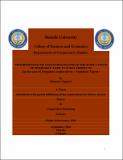| dc.description.abstract | The main theme of this thesis is to analyze the impact of supply chain of perishable
agricultural products on income derived from vegetables. The study is conducted
particularly focusing on irrigation cooperatives located in the southern zone of Tigray.
This is due to the highest number of irrigation cooperatives members in the region.
Among the vegetables the particular emphasis of the study is on income derived from
three vegetables. These are onion, potato and tomato. These vegetables are preferred, on
one hand for the reason that they are major sources of income in irrigation cooperatives,
and on the other hand for the reason that there are so many constraints in relation to the
perishable nature of the products which affects the producer’s income. A total of 120
households from vegetables producers irrigation cooperatives (16 female headed
households and 104 male headed households) drawn from two southern zone Woredas.
To collect the necessary data for the analysis structured and pre tested questionnaires are
used. Focused group discussion and key informant interview are also conducted.
Secondary data on basic agricultural and population is also collected to strengthen the
analysis. The analysis is conducted using descriptive statistics and empirically. The
analysis of the collected data showed that most of the households are illiterate (40.8%).
The average age of the households is 40.03 years. The average family size is about 5.41
of which the active labor force is 3. The average land holding is about 0.47 hectare per
household of which 0.25 hectares of land on averages used for vegetable production per
household. The average ownership of livestock is 4.34 TLU. The majority of the
households in the study area become a member of irrigation cooperative voluntarily. The
majority of the households identified that irrigation water management and provision of
fertilizer as a major benefit obtained from the cooperative. The average years of
experience as a vegetable producer of the households is 6.7 years and as cooperative
members the average years are 4.6. The income sources of the households are both from
agricultural and non agricultural income sources. The average income the households
received in the crop year 2008/09 was 10,672.15 birr. Of the total income the average
income from off farm activities was 1,095.25 (10.26%) birr. From agricultural activities
the households on average received 1267.45 (11.9%), 6,719.83 (62.97%), 1589.61
(14.9%) and 6.66 birr from crops, vegetables, livestock and bee colony respectively. The
xvi
total income received from sold onion, potato and tomatoes were 806,380 birr in the
study area. A total of 748 quintal of onion, 662 quintal of potato and 953 quintal of
tomatoes were sold in the production year 2008/09. The average price received per
quintal for onion, potato and tomatoes were 364.34 birr, 352.65 birr and 315.20 birr
respectively. This income was the highest income received by the households from
agricultural income sources. From the identified market channels the channel that
stretched as producer – wholesaler retailers, producer – cooperatives – wholesalers -
consumers, and producer – wholesalers - out of region are some of the forms of supply
chain used for vegetables by the produces. In the supply chain of vegetables wholesalers
are found to be the dominant buyers of vegetables. Among the constraints of income
from vegetables land size, fertilizer in terms of its cost, perishable nature of the product,
shortage of improved seed, irrigation water shortage, storage, technical assistance both
for production and marketing, lack of training from the cooperatives and disease and
pests are among the major ten rated constraints of income from vegetables. The
econometrics result for the determinants of income from vegetables, among the
hypothesized seventeen variables six of them found significant. These are vegetable post
harvest loss, crop income, distance from major market, distance from major road, off
farm income and livestock income. Livestock income is the only variable which affects
vegetable income positively. Post harvest loss and crop income are highly significant
factors to affect income from vegetables. Other variables like land size, credit, extension
service, price information and improved seeds are not significant as expected though they
exhibited positive relationship with vegetable income. Based on the constraints to
increase income from vegetables, improving the availability and developing ways in
reducing the price of inputs, developing drought resistance varieties of seeds, developing
crop insurance schemes with minimum premiums, developing farm plan budget,
analyzing the cost benefit of market choice, analyzing the opportunity cost of crop and
vegetable production are some of the recommendations suggested to increase income of
the households in the production of vegetables. | en_GB |


